
VR Symphony Orchestra
Lead Designer (2017)
VR Symophony Orchestra was completed during the Reality, Virtually Hackathon that I was invited to participate in at the MIT Media Lab in October of 2017. During this project, I acted as both the Lead UX Designer and 3D Modeler for the application. I worked directly with the sound designer and developer to create a seamless VR experience that taught the user about the role of conducting an orchestra. We did this through hand input with the Leapmotion headset.
INTERACTION & UX DESIGN
Concepting and Sketches
I mapped out the environment as well as all of the models within that environment. We determined that there would be a significant amount of instruments to interact with in order to retain the realness of a symphony hall.


3D Art and Implementation
Seen below are some of the models that I created. Prior to this project, I had no idea how complex and intricate instruments were (having never played one myself) and I welcomed the opportunity to create new models for the interaction system.
I also had the pleasure of designing the environment that the instruments existed in, which was difficult as the instruments had to be visible and understandable from a new user perspective.


Once we had the environment and the conducting motions mapped out, we started to place our objects into our environments. Our developer was able to play-test each instrument interaction in it’s entirety, as well as have it paired with an instrumental accompaniment – created by our sound designer.


POSTMORTEM
Lessons Learned
This project was an incredible opportunity to create a project in VR using the Leapmotion Orion system again. I utilized the learnings in my previous experience to create a better onboarding for the end user which included text and pre-recorded motion for the fingers and hands. We had to take into consideration the interaction system we required the user to complete was incredibly complex and based off of musical education.
One of the biggest difficulties was getting users accustomed to such an expansive space with a multitude of objects. We attempted to mitigate this by starting the user out with only string instruments and then building up the instruments over time.
We place in the top 10 teams at the hackathon for both originality in VR and in VR Education. I am so proud of my team and the work that we completed during this short time. It was truly an amazing experience.